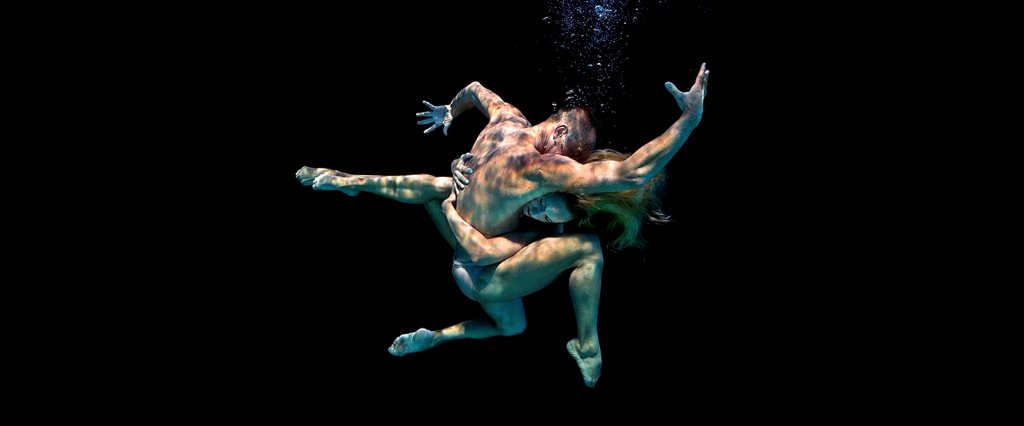On July 26, 2015, at the World Aquatic Championships in Kazan, Russia, Bill May became the first man to ever win a gold medal in synchronized swimming. Yet despite training for the past 23 years with Chris Carver, the American synchronized swimming choreographer who has coached dozens of world champions and Olympians (all female), the 39-year-old Syracuse native remains barred from competing in the Olympics because of his gender.
That’s particularly ironic given that some believe the sport was invented by Benjamin Franklin, and 19th century synchronized swimming competitions in Berlin and London were solely for men who did water dances surrounded by garlands and lanterns. They soon learned, though, that women are far more buoyant, particularly in the legs, and the sport evolved into a predominantly female pursuit. In the U.S., men were allowed to participate with women until 1941, when the governing body required they compete separately. This resulted in the aquatic version of “male flight” — when men leave certain domains once women successfully integrate into them (and which happened in cheerleading and flight attending).
Needless to say then, men have never been welcome in Olympic synchronized swimming, which debuted at the 1984 Summer Olympics (and was officially renamed “Artistic Swimming” in 2017). Local synchronized swimming clubs in the U.S., too, were solely comprised of females until the 1990s, when the 10-year-old May began training and performing with two New York teams — the Syracuse Synchro Cats and the Oswego Lakettes. After moving to California at 16 and living with a host family, he tried out for Carver’s nationally renowned Santa Clara Aquamaids and earned a spot on their junior squad. It looked for a minute like May would get to compete in Athens in 2004, but the national synchronized swimming federation never filed a petition for inclusion. “We just cannot allow men in a women’s sport,” Ginny Jasontek, the president of the federation, explained at the time.
Shunned by the sport he’d devoted his life to, May turned to Plan B: Making $100 a night swimming for Cirque du Soleil in Las Vegas. Today, when he’s not performing, he’s training to defend his gold medal at the next World Aquatic Championships in South Korea. (While men remain shut out of the Olympics, the U.S., Canada and most European countries allow men to compete in national and world competitions.) And God willing, he’ll be able to make his Olympic debut at the 2020 Summer Games in Tokyo — if the powers that be finally come around to men competing in a woman’s sport.

Whenever people tell me I can’t be a synchronized swimmer because it’s a “girl’s sport,” it only makes me train harder and practice longer. Who are you to tell me what I can do in my life to bring me joy?, I think, as I dive into the pool before sunrise.
When I was 12, all my gymnastic buddies thought I was weird for doing synchronized swimming. I’d push back just as hard as they’d poke, though. Besides, I was still playing basketball and football — this was just another way to have fun in the pool. My sister had synchronized swimming after my swim practice, so it was either sit and watch or join in. I figured I’d just do it for the summer, but then the coach asked if I wanted to try out for her team, the Syracuse Synchro Cats.
It wasn’t about me trying to match the girls, though. I wouldn’t do the really feminine moves — for my first solo, I chose Don Quixote over Ariel from Little Mermaid. Then, when the Synchro Cats disbanded after the 1993 season, I swam with the Oswego Lakettes for two years. The coach said, “If you really want to continue with this sport, you’ll get more opportunities training with Chris Carver and the Santa Clara Aquamaids.” She worked with athletes from all over the world, so I asked if I could train with her and she said yes.
The big issue was that I had to move to California to do so. I was very close with my family, so it was difficult to leave. But I had a dream to be the best synchronized swimmer I could possibly be, and the only way to do that was to train with the best club in the world. And like that, I was among female Olympians, world champions, and the best coaches on the planet.
One other man from France was there briefly, but throughout most of my career, I’ve been the only man training. We did have a male coach who swam for France for many years who explained that men don’t swim like women — not physically, not mentally — and are completely different physiologically. Men have more muscle mass so we don’t float as much. That’s a problem in synchronized swimming because you’re scored on how high you get out of the water. Also, men are less flexible, so elegant movements can be a challenge. That said, we’re psychically stronger, so there are definitely some advantages, too.
In 1995, I was helping train the female Olympic team that would go on to win gold in Atlanta in 1996 with a perfect score. That year, Coach Carver had a vision of a man and female swimming together in what she called “the mixed duet.” She said it would showcase the strengths and the relationship between me and my partner, because instead of just two people just swimming side-by-side doing the exact same thing, this would have a narrative, similar to pair ice skating. We actually formatted our routines from Torvill and Dean, famous ice dancers from England.
We won every time we competed. The Russians petitioned against me swimming at the German Open, but they were asked to leave. This strengthened my intentions to keep going because it showed there was support for me and for all men in synchronized swimming. This was a fight for equality.
Ten years later, that determination paid off. The national team director said they’d voted to welcome mixed pairs into the world championships in Kazan, Russia in 2015 and asked if I could go. I immediately went full force into training.
The average age of an Olympian is mid- to late-20s. That meant I’d definitely be older than most synchronized swimmers, but it was just another challenge to overcome. It had always been my dream to compete against the world’s best — often the Russians — which would allow me to learn new styles and improve my own technique.
Because it was the first mixed competition, we hadn’t a clue what the other countries were going to do as a mixed duet routine. We ended up choreographing it more as male and female, whereas other countries did it like two females, one of whom just happened to be a male. From our point-of-view, though, we were trying to push it as a completely separate event — a male and female swimming together.
Some people didn’t like our free program because they didn’t know how to judge it. They’d been trained to say, “Okay, I see two legs up in the air that look exactly alike; they’re as high as possible; and it’s moving as fast as possible.” But a man and woman swimming together isn’t going to look the same because males and females look different and the intention of our movements are different.
Since it’s the host country, Japan can greenlight the mixed duet to debut at the 2020 Olympic Games in Tokyo, which I always thought would be special since my current partner, Kanako Kitao Spendlove, is Japanese. It’d be nice to finish our careers in her home country by competing for the U.S. on such a monumental stage. We’re certainly pushing for it.
More importantly, hopefully when young men watch me compete in Tokyo and see how happy I’ve been throughout my career, it’ll inspire them to try synchronized swimming. That’s where I hope I can help: To show them that you’re not being compared to the girls — you’re complementing them.
— As told to C. Brian Smith

